Biographies of Marmaduke and Isaac Storr Hutchinson
The three sons of Isaac Hutchinson and his second wife Phoebe of Bucks County, Pennsylvania, were Marmaduke, Isaac Storr, and Thomas Hutchinson (1). The brothers were farmers in New Britain Township (2) and listed among those proclaimed as traitors, “attainted of High Treason in pursuance of the Treason Laws of the State of Pennsylvania” (3). Following are brief biographies of two of these men.
Marmaduke Hutchinson (linked to Genealogies page)
Marmaduke Hutchinson was born 7 Apr 1755 (1), probably in Bucks County, PA. He was listed as a non-associator in New Britain Township by the Committee of Safety in 1775 (4). His refusal to participate in the American Revolution was presumably due to his Quaker convictions for peace and a desire to maintain membership in the Society of Friends. The charge of treason caused him to flee from Pennsylvania, by this time apparently married to wife Martha, and having at least one child. They must have stayed for a time with the Quaker community at Crosswicks, NJ, for he later reported being from that town (5). This time was difficult for many Quakers, and the Quakers in Britain and Ireland were raising relief funds for their distressed Friends in America. Marmaduke and family would, much later, be beneficiaries of these funds.
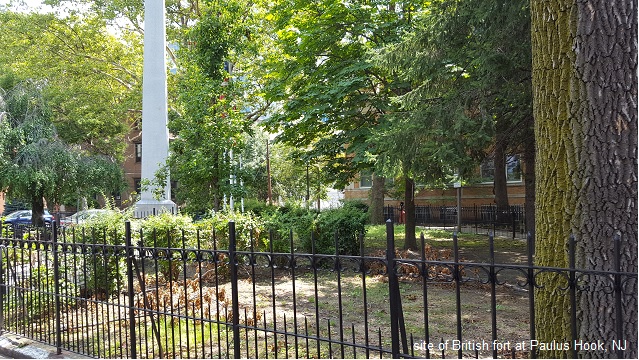 Source: Andrew Quackenbush
Source: Andrew Quackenbush
t was at Paulus Hook, NJ, across the Hudson River from New York City, where Marmaduke is next located, on 26 Aug 1781. At this time, New York was a garrisoned city under British control and a place of protection for thousands of Loyalists. Marmaduke was included in the muster roll of the British army’s engineering department working at Paulus Hook as a carpenter (6). Given Marmaduke’s views on the war, he may have taken his job with the army reluctantly, but the influx of people and shortage of work would have left him without options. It is likely his work as a carpenter involved building British fortifications. He was not part of the British regulars, but rather working alongside the British American regiments, the Provincials.
According to Bell’s interesting book, Early Loyalist Saint John: The Origin of New Brunswick Politics, the Loyalists became increasingly dissatisfied in New York because work was scarce, the city was strictly regulated, and the British regulars treated the Provincials with contempt. Thus, when Britain agreed to independence for all thirteen colonies without negotiating any protection for the Loyalists, many felt no choice other than evacuation. Bell contends that to suggest the Loyalists were willing martyrs for a political cause is largely false. Generally the Loyalists disagreed with the high taxes Britain imposed, but they felt fighting to become a separate nation was the wrong solution. Loyalists generally did not want to abandon their country or face exile; in fact, many tried to return to their properties rather than face the wilderness of Canada, but the Patriots forced them back to New York (7). Given the charges against him, Marmaduke would not have been among those who risked returning home. While waiting for a ship to evacuate them from New York, his family was listed as one man, one woman, one child 10 years old or more, and one child under 10. His former home location was not listed in the enumeration (7).
There were several fleets that left New York between May and October 1783. The nearly fifty ships leaving from Sandy Hook on May 27th, a sailing known as the Spring Fleet, were the first to go, and the Hutchinsons were on one of the 10 ships bound for Saint John. This fleet left six months before Paulus Hook was given up by the British. The Saint John group was under the control of The Bay of Fundy Adventurers, one of several private associations that organized evacuations in conjunction with the British military and Governor Parr of Nova Scotia (7). There were Quaker groups that organized themselves for transportation, but the Hutchinsons were not among the passengers.
The Hutchinsons were not listed as passengers on the Union, so they must have sailed on one of the other nine ships, possibly the Duchess of Gordon or Sovereign, both of which delivered passengers up the Saint John River where Marmaduke and family eventually settled (8).
Passengers received rations from the British government. Provisions were distributed first on board the ship by the captain, and later, after arriving about June 10th, by British government officials at the port of Saint John. The Hutchinsons were civilian refugees rather than military loyalists, receiving rations for at least 70 days (7). The ages of children were sometimes inflated to achieve adult rations, but if Marmaduke and Martha did not report a false age for the elder child, and if they were married prior to the child’s birth, Marmaduke and Martha must have been married young, around age 17 or 18. Martha’s first name is known from land documents found at the Provincial Archives of New Brunswick (9). Her surname may have been Leigh (10).
The colonial government was ill prepared for the vast numbers of people arriving. Saint John had only a few buildings at the landing of the Spring Fleet, so the refugees used small military tents for shelter (7). If the Hutchinsons were among the majority, they would have built a small shelter from supplied lumber and stayed the first winter in Saint John because their lots upriver were not yet surveyed. Wood and food were scarce, so at the earliest opportunity, they would have travelled up the Saint John River. As they were listed at the food distribution in May 1784 but not in June, it seems likely they moved between these two enumerations.
Several of the arrivals on the Spring Fleet settled on a land grant near Maugerville, and the Hutchinsons were among them (7). Marmaduke settled on a strip of 75 acres of rich wetlands, Spray’s Grant Lot 10, which spanned the isthmus between the Saint John River and Grand Lake. The land, now known as the Grand Lake Meadows, is part of a large plain prone to spring flooding. The river end of the property is situated near the north end of the present (2008) Highway 2 bridge across the Saint John River.
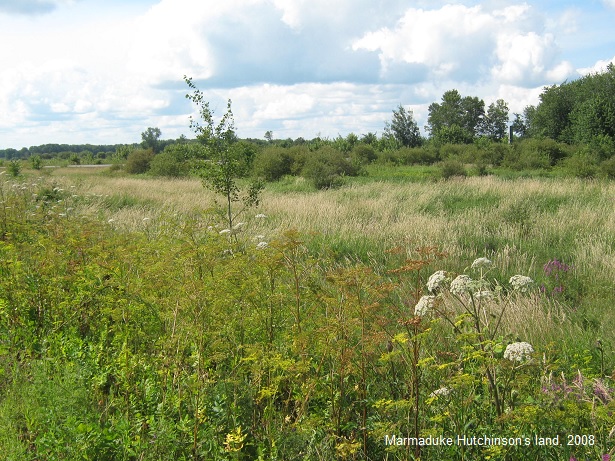 Source: Andrew Quackenbush
Source: Andrew Quackenbush
By April 1786, 8 acres had been improved, and the Hutchinsons had established one house and out building and had three cows and two hogs (11). In June, five acres were in crops (12). Marmaduke’s petition for the land he had settled upon indicates that he had been registered on an unfavourable property at Lot 72 Gage Town. This land is on the other side of the river about two kilometres upstream. These locations are labeled on a cadastral map for Canning Parish (13). It was about this time that my ancestor, their daughter Dorothy, would have been born, but there is no record of her birth as no Quaker meeting was yet established in the area.
In the summer of 1787, Joseph Moore and Abraham Gibbons did an enumeration of Quakers in New Brunswick for the purpose of distribution of aid to the needy. Funds had been raised by Irish and British Quakers, and while distribution in the earlier years had been limited to America, a cargo ship bound for New Brunswick and Nova Scotia was funded at the cost of £503. The ship sailed in July 1788, with half of its cargo allotted to Saint John and area. Among the recipients were several who reported themselves to be from Crosswicks NJ, Marmaduke among them. He was listed as a farmer at Maugerville. What the Hutchinsons received is unspecified, but the cargo contained clothes, farming tools, and money (14).
Two years later, by September 1789, the Hutchinsons had moved to the head of Grand Lake at the mouth of the Salmon River, cleared a dozen acres, and built a house (15). Their neighbour there and good friend, Anthony Terrill, had arrived in the Spring Fleet on the Camel. Other neighbours had come to New Brunswick later in the 1783 season: the Arthur Branscombe family on the William at the end of July, and the Roger Barton family on the John & Jane in mid October. A Jacob Reynolds, possibly the one who became the son-in-law of Marmaduke, arrived on the Nancy in the same fleet as Roger Barton. Jacob had no family on the ship nor at the food distribution in May 1784 (7). This Jacob is possibly the one who petitioned for land near the mouth of the Richibucto River soon after arriving but was a neighbour of Marmaduke's at Grand Lake by 1795 (16). The father-in-law of Marmaduke's son Samuel was Timothy Wood who arrived on the Bridgewater with his wife and one child under 10. Before leaving NY, there was an older child enumerated (7), so presumably that child was left behind, died, or was counted elsewhere after arriving in NB.
The location of the Hutchinsons’ property at the head of Grand Lake can be determined from land petition descriptions and identification of his neighbours. In particular, a description of land in a sale by Anthony Terrill is helpful: “all that messuage or tenement, called Mount Pleasant situate lying and being north Eastern side of the entrance of Salmon Bay bounded by Marmaduke Hutchinsons lot on the south eastern side containing two hundred acres more or less, also a lot of land opposite on the south western side of Salmon Bay containing seventy five acres more or less bounded by Marmaduke Hutchinsons lot on the south eastern side..." (17). Marmaduke’s property, then, was later numbered as lots two and three, which straddle the entrance to Salmon Bay and were owned by David Sypher on the cadastral maps (18). I visited and photographed the property in 2013 by driving to the end of Salmon River Mouth Road and found it to be partly wooded on low ground with a few residences. The land can be viewed easily from across the lake at the end of Range Wharf Road. In 1796, the land was described as wild meadows with “the Lands joining is nothing scarcely but burnt Land grown over with Moss and Hurtlebury Bushes” (19). There is a Hutchinson Brook located north of the property Marmaduke owned. The brook is roughly a kilometre NE of Chipman at 46˚12’ N, 65˚51’ W (20).
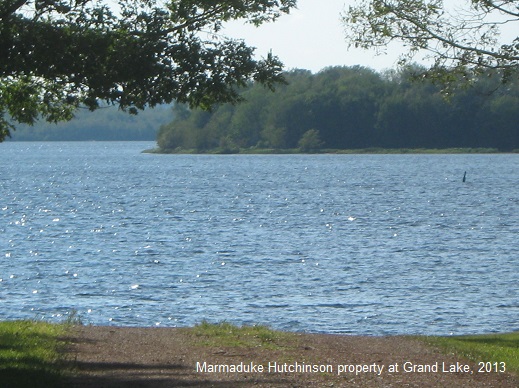 Source: Andrew Quackenbush
Source: Andrew Quackenbush
The Terrills were on the northwest side of Marmaduke, with Roger Barton, Arthur Branscombe, and John Miller across the lake to the south where they were granted lots 5, 12, and 17 respectively in the first Range on the south shore of Cumberland Bay. These men and many descendants are buried in cemeteries there and have stones that are presently in good condition.
In January, 1797, Marmaduke petitioned for an additional 200 acres as his farm was too small for his growing family (21). Three years later he sold his initial 75 acre property at Lot 10 in Spray's grant for £150. He continued on his farm near the village that had grown up where he had established himself a dozen years earlier at the mouth of the Salmon River. The journal of Rev. Joseph Hoag, a Quaker preacher, refers to Marmaduke’s property in January, 1802: "...feeling my mind drawn towards a village at the head of Grand Lake, I proposed to Benjamin Birdsall to take us there. He took us to Marmaduke Hutchinson's, where we found Friends who were glad to see us. We had a meeting at his house the next day; and they being much beloved by their neighbors, and living near the village, the meeting was large…” (22).
Marmaduke’s son-in-law, Jacob Reynolds, granted power of attorney to Marmaduke on 20 Aug 1801 (23), apparently in preparation for a move to Prince Edward County, Ontario. On 22 Mar 1805, Marmaduke sold Jacob’s Lot 15 Range 1 along Grand Lake and signed the instrument before the Justice of the Inferior court of Common Pleas on 27 Jan 1807 (24).
Soon after this date, some of the Hutchinsons moved to Prince Edward County in what is now Ontario, settling in Hillier, but later land records indicate others stayed behind, residing on land in the Grand Lake area for decades. Hillier was where Marmaduke’s older brother Isaac Storr Hutchinson would settle in later years, possibly drawn there not because of his brother Marmaduke, with whom his contact seems limited, but to be with his wife’s family, whom he met in Nova Scotia.
The Marmaduke Hutchinson family became active in Quaker meetings, with Samuel, believed to be Marmaduke’s son, first appearing in the Adolphustown minutes in the summer of 1808 (26). These records show that Marmaduke was received into membership in the fall of 1809 along with Grand Lake neighbour Anthony Terrill and their wives, Martha and Charity, about the same time.
The name of Marmaduke Hutchinson continues to appear in documents for some time, but some references are certainly for Marmaduke Jr. Isaac Storr Hutchinson was still alive in 1820, so his younger brother Marmaduke surely could have been also. They are probably those men of the same names who had letters waiting for them at the Kingston Post Office on the same day in 1820 (27).
Isaac Storr Hutchinson
Isaac Storr Hutchinson, born 1 Jun 1746 (1), was the eldest full brother of Marmaduke. He was farming in New Britain Township, Bucks County, PA, on or prior to 30 Oct 1778 (3), and like his brother fled from Pennsylvania, escaping punishment for treason. Isaac’s route to Nova Scotia is still unknown, but it may have been similar to that of John Meredith, a loyalist whom Isaac testified in support of his claim for losses. Meredith left New Britain in June 1777, arrived in New York in July 1778, and served in the militia in the works at Brooklyn (28). While Isaac was familiar with the New Britain property Meredith had inherited from his father, he had only “heard” of Meredith’s service in Brooklyn. Regardless, both Hutchinson and Meredith ended up in Granville, Nova Scotia.
Also living in the Township of Granville was Thomas Hutchinson, the sole Hutchinson having sailed 19 Oct 1782 on the ship HMS Amphitrite from New York (29). As Marmaduke and Isaac Storr had a brother Thomas (1), there is the possibility that this is he, but I have yet neither established nor disproven this connection.
One source (30) indicates Isaac settled at Granville but planned to settle at nearby Gulliver’s Hole, which is now Gulliver’s Cove in Digby Neck, Nova Scotia. Another source (31) provides similar information but records that James Hutchinson was the settler planning to move. Perhaps there is a transcription error, or perhaps there were two Hutchinson men who both planned to move. This latter case is plausible given that the two witnesses to the John Meredith property compensation claim mentioned above were Isaac and James Hutchinson (28). Near Gulliver’s Cove is a waterway called Hutchinson’s Brook (32).
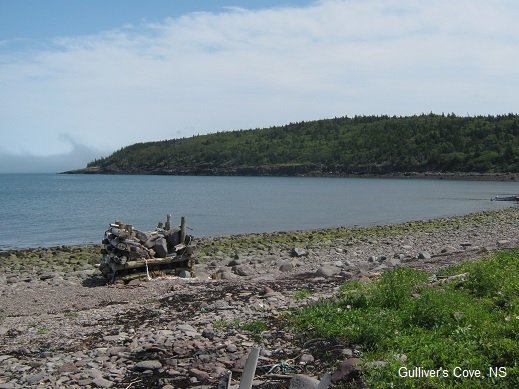 Source: Andrew Quackenbush
Source: Andrew Quackenbush
On 20 Feb 1784, Isaac, Thomas, and J.S. [probably James] Hutchinson were among many loyalists who drew lots for property in the Botsford grant in Digby Township (33). This area is adjacent to Granville. These three men drew boards and shingles, supplies provided to the settlers by the British government.
The Isaac Hutchinson of Granville was from New Britain Township and had the middle name “Storr.” For these two reasons he is confidently placed as the “Isaac Storr Hutchinson” listed as the brother of Marmaduke in the Hutchinson bible. The fact that Isaac later settled several hundred kilometres west in the very same township where Marmaduke had established himself in Ontario is not, as I at first believed, evidence of the relationship. I am fairly sure this event is coincidental, for Marmaduke and Isaac’s wife’s family do not appear to have known each other, nor did they both arrive in Hillier at the same time – Marmaduke settled there a decade after his sister-in-law’s family.
It is in the land records where Isaac’s middle name appears. Isaac Storr Hutchinson was deeded 100 acres at Lot 2 Granville by Robert Young and wife Jean for seven years beginning 9 Jan 1784. The transaction was made on the condition that Isaac live on the land and improve it, and that the Young family have the right to make cart roads over the land at their convenience (34). There was no mention of funds paid, suggesting that the marriage of Isaac to Robert Young’s daughter Mary (35) had already taken place by this date.
From the survey description, it is determined that Lot 2 lay to the south of Lot 1, which was on the south shore of the Bay of Fundy. The mention of “Bay Shore” and the “mountain” suggests the land was close to the intersection of present day “Shore Road” and “Youngs Mountain Road,” midway between Annapolis Royal and Bridgetown in Granville Township. This should be confirmed by accessing historical maps. The land described as “back of lands of Robert Young” (36) seems to suggest Young owned Lot 1. Lot 2 was mortgaged to Esau Cox only three months later for 21 pounds and then purchased back by Robert Young in October of that year (36).
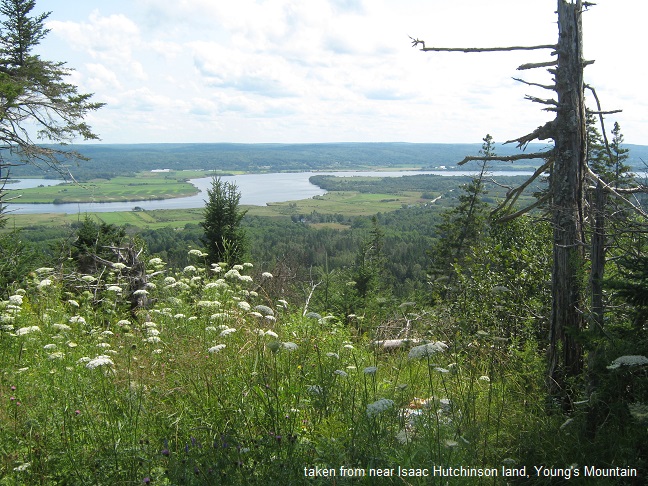 Source: Andrew Quackenbush
Source: Andrew Quackenbush
Mary, daughter of Robert Young and wife of Isaac, was born 26 Nov 1766 in Granville (37). She must have married Isaac at a young age, he being twenty years her senior. They had at least two children, Joseph and Mary (35). More research is needed, but census data and Mary’s birth year suggest Joseph was born about 1784. There was possibly another child, Isaac, of similar age to Joseph, but this is yet unconfirmed.
Edward Winslow was an influential loyalist in Granville who knew Isaac. Winslow had escaped to Granville in 1783, but in 1785, moved briefly to Saint John NB and then upriver to Fredericton. He brought his siblings and mother to join him there in 1787 (51). It may have been that Isaac was persuaded to go with this group, for Isaac brought his wife and family to Fredericton in 1787 for the purpose of settling there. He petitioned for town lots 34 and 36, followed shortly afterward by two other petitioners desiring the same lots (52). The lots had been laid out the previous year. Isaac was the first owner of the land on the northwest corner of Carleton and King Streets, property now occupied by the grand Wilmot United church, established in 1791 with the current building dating from 1851 (53).
Winslow, later a politician and judge, sent a letter in 1787 to Thomas Aston Coffin, civil secretary and controller of public accounts, who resided in Quebec (38), and then it was forwarded to Hugh Finlay, deputy postmaster general of the province of Quebec. Finlay was intent on establishing an overland route for the mails between Quebec and Halifax using the Saint John River, and was thus interested in making the river route as convenient as possible (39). One obstacle was the cataract at what is now Grand Falls, and Winslow’s letter was important as it identified Isaac as a person willing to settle there, for a purpose made clear by Finlay: “ ‘…if some person were settled on that spot, who would keep proper stores for supplying travellers, it would render journeying on that route much more comfortable than it is at present.’ I think it is exceedingly lucky for the public that a man of so good a character has undertaken to sit down on that portage with his family. It will be of great convenience to the Couriers, and will contribute to their ease and speed” (40). Grand Falls is both a city and impressive cataract through a gorge, though the beauty is reduced by a dam built at the falls’ crest. A visit there in 2013 allowed views of the falls from several vantage points, including a traffic bridge over the gorge below the falls. An adjacent museum reveals a little of the falls’ history.
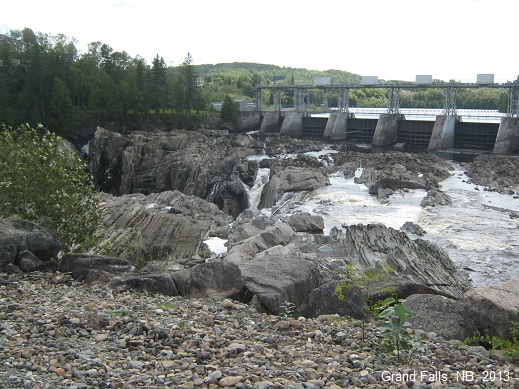 Source: Andrew Quackenbush
Source: Andrew Quackenbush
Isaac did indeed move to Grand Falls, and appears to be the first settler, or nearly so. Whether he took his family or left them in Fredericton is unclear. Isaac’s supply depot may have been on the short portage route that crossed the base of the peninsula formed by a loop in the river, close to Court Street today. In 1791, Isaac sold his property and improvements to Pierre Dupere (41). There is no deed description for this transaction, nor for a subsequent sale of land by Dupere in the area, but the sale coincided with the military taking over the portage to supply travellers and to establish a military post to protect the mail route and defend against American land claims of the area (42).
By 1794, Isaac had returned to New York City with his family. This was determined in the following manner: Pioneer Life on the Bay of Quinte lists Isaac as having one son, Joseph, and also indicates that descendants lived in Trenton, Ontario, by the turn of the 20th century. Any of Isaac’s Hutchinson descendants in Trenton, then, would be descended from Joseph, the sole male child known by the author. Other than Marmaduke’s descendants, the only Hutchinson there was a Joseph, born about 1814 in New York, and the 1891 census for this Joseph lists his father as born Nova Scotia. Thus, Isaac had a son Joseph born in Nova Scotia who lived in New York in 1814 at the birth of his child, also named Joseph. Examining American documents led to the discovery that Joseph had indeed lived in New York City, and more surprisingly, that Isaac Storr Hutchinson himself had returned there for many years after his exile.
Isaac was there only a short time when “at the City Hall of the City of New York of the Term of April in the Year of our Lord One thousand seven hundred and ninety four Isaac Storr Hutchinson was convicted of a certain felony by him done and committed; and afterwards to wit in the Term of January in the Year of our Lord one thousand seven hundred & ninety six Judgment was thereupon given in the said court against the said Isaac Storr Hutchinson that he should be hanged by the neck until he should be dead…” (43) His death sentence was for knowingly “uttering forged promissory notes for the payment of money” (44). Twice the Governor of New York, John Jay, granted a stay of execution, delaying the hanging until 22 Apr 1796 and then again until 5 May 1797. Fortunately for Isaac, he received a pardon by Jay on 30 Apr 1796, a year before he was to meet the willow tree.
Earlier it was mentioned that Isaac Storr and wife may have had a son named Isaac. Including the Joseph and Mary recorded as children in Pioneer Life on the Bay of Quinte, Isaac should be found in the 1800 census of New York with a household of five. There is only one Isaac Hutchinson in the state, and he is found in what is now Castleton Corners in the borough of Richmond, New York City, with five in the household. The ages for both parents and all three children are compatible with what might be expected, but the record shows two girls and one boy rather than two boys and one girl.
In 1810, Isaac and his wife were in Ward 6, and next to them was a younger Isaac, born as late as 1784, living with, presumably, his wife, born 1785 or later. It is this entry that suggests Isaac Storr had a son Isaac. Isaac’s son Joseph, born as late as 1784, was living nearby in Ward 7 with six others, presumed to be his wife, three young sons, and two daughters (45). Joseph’s son Joseph was born in the city on 15 June 1814 (46). Wards 6 and 7 touched corners at the intersection of Bowery, Division, Catherine, and Chatham Streets. Ward 6 was bounded by Broadway, Canal, Bowery and Chatham [now Park Row] Streets, and Ward 7 was bounded by Catherine, Division and Grand Streets (47).
Microfilm images of Longworth’s New York City directory for 1813 shows that Isaac S Hutchinson, and another Isaac, presumably his son, were both living at 10 Mott St. Joseph was living a few blocks to the south.
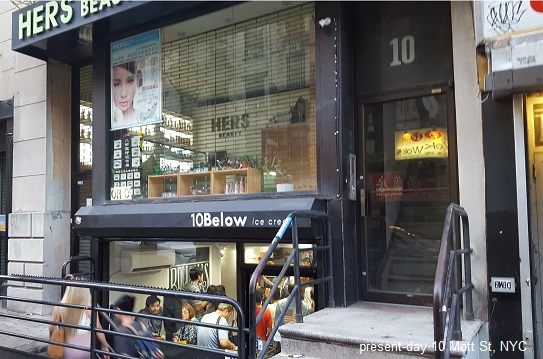 Source: Andrew Quackenbuh
Source: Andrew Quackenbuh
During 1815, an Isaac Hutchinson appears in the city as a carpenter (48), and this is perhaps the younger Isaac. Isaac S Hutchinson, undoubtedly the elder, was recommended as inspector of firewood in April of that year, although Allan Royse, also recommended, was eventually appointed on June 8th as the inspector at Spring St. and Thompson’s Wharf (49).
When Isaac and wife returned to Canada is not precisely known, but his grandson Joseph, born in New York City, reported at age 86 to an enumerator that he had immigrated to Canada in 1823 (46). This date is somewhat suspect, for Isaac was already in Canada by 1820 (27), though it is entirely possible that he and Mary went to Canada first and were joined later by their son Joseph and his family. Isaac went to Hillier Township in Prince Edward County, Ontario, to an area where some of Mary’s siblings lived at Pleasant Bay, Hillier Township. Just north of this is the area where Mary’s parents had settled after moving from Nova Scotia. According to Pioneer Life on the Bay of Quinte, Robert Young had located in 1796 just south west of Carrying Place at Lot 1 Ameliasburgh, which today contains Parkview Road, and he also had lands in Hillier. The date provided in Pioneer Life is consistent with the list of Annapolis regiment militia captains, from which Robert disappears after 1796 (31). Lot 1 was inhabited by Robert’s descendants until at least the publication of the township’s historical atlas in 1878.
Isaac died 17 Apr 1825, his death notice appearing in two newspapers of the time. The Upper Canada Herald records, “Hutchinson, Isaac. In Ameliasburgh on 17th ult., Isaac Hutchinson in the 78th year of his age, for several years a resident of that place. His funeral was attended on Monday, at the School house (Carrying Place), where a sermon was delivered by the Rev. Mr. Breakenridge” (50). Mary’s father, Robert Young, died a year later aged nearly ninety and was buried at the Carrying Place Cemetery.
Some notes:
Marmaduke was the father of my ancestor Dorothy, and I have been searching for her parents since the 1980’s. The arrival of the Internet assisted greatly in finding clues, but if anyone knew the stories of Marmaduke and Isaac, they weren’t online at the time. It was the rarity of the names Marmaduke and Storr that allowed the original tracing of these brothers from Ontario to New Brunswick to New York to Pennsylvania. Much Hutchinson research on the American families and in England had been done by others, and so I have not done any original work on my line beyond Marmaduke. I did, however, visit Owstwick and area in Yorkshire, England, in 2004 to visit the place where the Hutchinsons came from, and it remains one of the most memorable genealogical trips I have taken.
I believe the construction of Marmaduke’s immediate family is done correctly, though it is incomplete and only partly proven (daughter Frances, for example, is known through property records, but son Samuel is assumed through circumstantial evidence). In the numerous trees that have been added online in more recent years, I still have not found anyone with sources to prove the more speculative parts of Marmaduke’s immediate family, and I would be grateful if anything can be provided.
Please feel free to distribute this document. I would ask that if you do further research or find errors in my work, that you kindly share your insights with me. If you use material from this document, please include me as a source so that others can contact me also.
Andrew Quackenbush,
September 2013
SOURCES:
(1) Hutchinson Bible purchased and transcribed by Richard S Hutchinson. Personal correspondence, July, 2009.
(2) Pennsylvania Historical and Museum Commission. (1907). Pennsylvania Archives, Series 6 Vol XIII. p. 468. Retrieved from http://www.fold3.com/image/3103402
(3) Pennsylvania Historical and Museum Commission. (1900). “Papers of the Governors.” Pennsylvania Archives, Series 4 Vol III. p. 696, 937. Retrieved from http://www.fold3.com/image/3129831
(4) Hazard, S. et al, Eds. (1896). Pennsylvania Archives. Severns & Co. Retrieved from http://books.google.ca.
(5) Mekeel, A. J. (1947). “Quaker-Loyalist Settlers in New Brunswick and Nova Scotia”. Bulletin of Friends’ Historical Association, 36 (1), Spring 1947, p. 29.
(6) Ruch, J. E. & Kipp, E. (1996). Carleton’s Loyalist Index. Ottawa: Sir Guy Carleton Branch. CD ROM.
(7) Bell, D. G. (1983). Early Loyalist Saint John: The Origin of New Brunswick Politics, 1783-1786. Fredericton, NB: New Ireland Press.
(8) Wiggins, E. Stone. (1993). The History of Queens County. Queens County Historical Society.
(9) Land records, Provincial Archives of New Brunswick microfilm F5455 #712.
(10) Ruth (Hutchinson) Alsemgeest. Personal correspondence, 2012.
(11) “Account of the Settlers, Improvements and Stock on Colonel Spray's Land on the River St. John taken in April 1786.” We Lived: A Genealogical Newsletter of New Brunswick Sources. Retrieved from http://freepages.genealogy.rootsweb.ancestry.com/~cannbfam/QU.pdf.
(12) Land records, Provincial Archives of New Brunswick microfilm F1031.
(13) Provincial Archives of New Brunswick, Canning Parish cadastral map. Retrieved from http://archives.gnb.ca/Exhibits/Communities/Details.aspx?culture=en-CA&community=591.
(14) Mekeel, A. J. (1943). “The Quaker-Loyalist Migration to New Brunswick and Nova Scotia in 1783.” Bulletin of Friends’ Historical Association, 32 (2), Autumn 1943, pp. 65-75.
(15) Land records, Provincial Archives of New Brunswick microfilm F1036 #478
(16) Land records, Provincial Archives of New Brunswick microfilm F1040, 1795.
(17) Queen’s County land documents, Book D, page 198 #694 dated 18 Nov 1799. Retrieved from https://familysearch.org/pal:/MM9.3.1/TH-266-11756-80951-64?cc=1392378&wc=M9ML-BL9:797390183.
(18) Provincial Archives of New Brunswick, Coal Creek cadastral map. Retrieved fromhttp://archives.gnb.ca/Exhibits/Communities/Details.aspx?culture=en-CA&community=798.
(19) Land records, Provincial Archives of New Brunswick microfilm F1040, 1796.
(20) Surveys and Mapping Branch, Department of Energy, Mines and Resources. (1994). New Brunswick. Retrieved from http://books.google.ca.
(21) Land records, Provincial Archives of New Brunswick microfilm F1040, 1797.
(22) Hoag, J. (1861). Journal of the Life of Joseph Hoag: An Eminent Minister of the Gospel in the Society of Friends. Auburn, NY: Knapp & Peck. Retrieved from http://books.google.ca
(23) Harriet Irving Library Loyalist Collection microfilm FC LPR.N4L3Q4R4 Reels 1-3
(24) Harriet Irving Library Loyalist Collection microfilm E 83 952
(25) Land records, Provincial Archives of New Brunswick microfilm. Land sale to Joseph Barton.
(26) The Trustees of the Canadian Yearly Meeting of the Religious Society of Friends. Adolphustown Monthly Meeting Minutes, 1798 – 1813. Transcribed by Tom Pollard.
(27) Macaulay, J. (1820, April 7). Kingston Chronicle, p. 3. Retrieved from http://ink.ourontario.ca/kg/kg1/KG_1820_04_07_3-x0-y0-z1-r0-0-0.
(28) Fraser, A. (1905). Second Report of the Bureau of Archives for the Province of Ontario. Toronto, ON: L. K. Cameron. Retrieved from ancestry.ca United Empire Loyalists, Parts I-II database.
(29) Hale, W. (n.d.) Wallace Hale’s Fort Havoc. Retrieved from http://archives.gnb.ca/Exhibits/FortHavoc/html/HMS_Amphitrite.aspx?culture=en-CA
(30) Muster Roll of Disbanded Officers, Discharged and Disbanded Soldiers and Loyalists transcribed from M.G. 23, D 1, Series 1, Volume 25 pages 1-470. Retrieved from www.rootsweb.ancestry.com/~canns/Loyalist1784.xls.
(31) Wilson, I. W. (1893). A Geography and History of the County of Digby Nova Scotia. Halifax, NS: Holloway Bros.
(32) Powell, D. (n.d.) Ross of Co Tyrone, Ireland. Retrieved from http://roots-boots.net/ft/ross.html.
(33) Smith L.H. & Smith N.H. (1992). Nova Scotia Immigrants to 1867. Baltimore, MD:Genealogical Publishing Co.
(34) Mortgages and Deeds, Nova Scotia Archives and Records Management microfilm 17022, book 5, p. 307-308.
(35) Morley, W. F. E. (1972). Pioneer Life on the Bay of Quinte. p. 1001. Retrieved from http://books.google.ca.
(36) Mortgages and Deeds, Nova Scotia Archives and Records Management microfilm 17022, book 5, p 180 -181.
(37) Burgess, R & Burgess, R. (2002). Granville Township Book. Annapolis: Annapolis County Macdonald Museum.
(38) Caya, M. (2003). “Coffin, Thomas Aston,” in Dictionary of Canadian Biography, vol. 5, University of Toronto/Université Laval. Retrieved from http://www.biographi.ca/en/bio/coffin_thomas_aston_5E.html.
(39) Steele, I. K. (2003). “Finlay, Hugh,” in Dictionary of Canadian Biography, vol. 5, University of Toronto/Université Laval. Retrieved from http://www.biographi.ca/en/bio/finlay_hugh_5E.html.
(40) University of New Brunswick. (2013). The Winslow Papers. Retrieved from http://lib.unb.ca/winslow/
(41) Land records, Provincial Archives of New Brunswick microfilm F1037
(42) Parks Canada. (2013). Canada’s Historic Places: Fort Carleton Commemorative Site. Retrieved from http://www.historicplaces.ca/en/rep-reg/place-lieu.aspx?id=9627.
(43) Jay, J. (1796).Governor's letterbook , Vol II. Retrieved from www.app.cc.columbia.edu.
(44) Jay, J. (1796). Governor’s letterbook, Vol I. Retrieved from www.app.cc.columbia.edu.
(45) Ancestry.com. 1810 United States Federal Census [database on-line]. Provo, UT, USA: Ancestry.com Operations, Inc., 2010. Images reproduced by FamilySearch.
(46) Ancestry.com. 1901 Census of Canada [database on-line]. Provo, UT, USA: Ancestry.com Operations Inc, 2006.
(47) Duke University Libraries. (n.d.) Mapping the City: A Stranger’s Guide. http://exhibits.library.duke.edu/exhibits/show/mappingthecity/intro/item/21065
(48) Longworth's American Almanac, New-York Register, and City Directory. (1815). New York: D. Longworth. Retrieved from www.ancestry.ca.
(49) Minutes of the Common Council of the city of New York, 1784-1831, Vol VIII. New York, 1917. p. 209, 226. Retrieved from http://archive.org/stream/minutesofcommonc08newy#page/n5/mode/2up.
(50) Lennox and Addington Historical Society. (2009). Death in Upper Canada. Retrieved from http://www.lennoxandaddingtonhistoricalsociety.ca/UCDeaths.html.
(51) Wikipedia. (2012). Edward Winslow (Loyalist). Retrieved from http://en.wikipedia.org/wiki/Edward_Winslow_(loyalist).
(52) Land records, Provincial Archives of New Brunswick microfilms F1033 and F1034.
(53) Wilmot United Church website (2013). Retrieved from http://www.wilmotuc.nb.ca/history.php.
